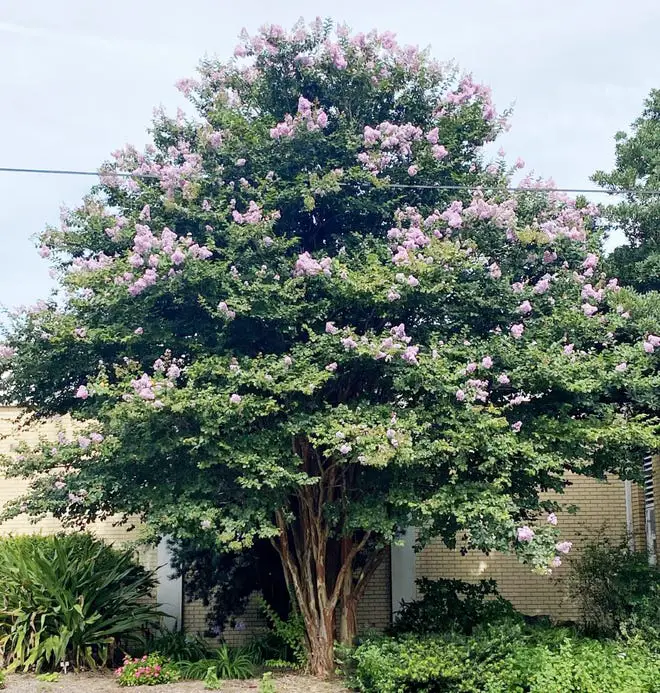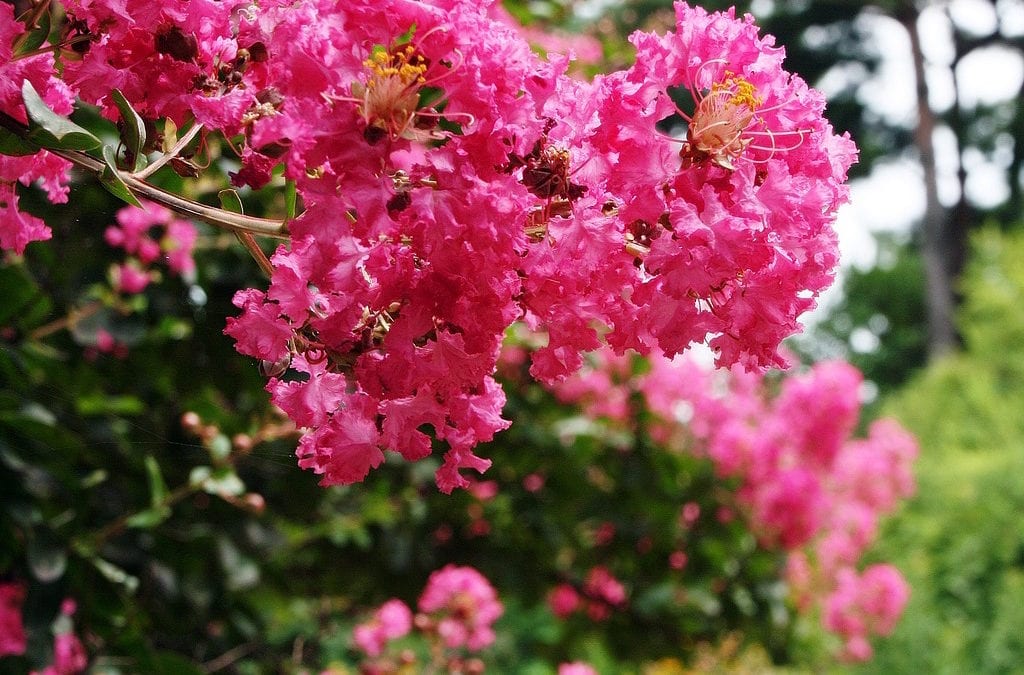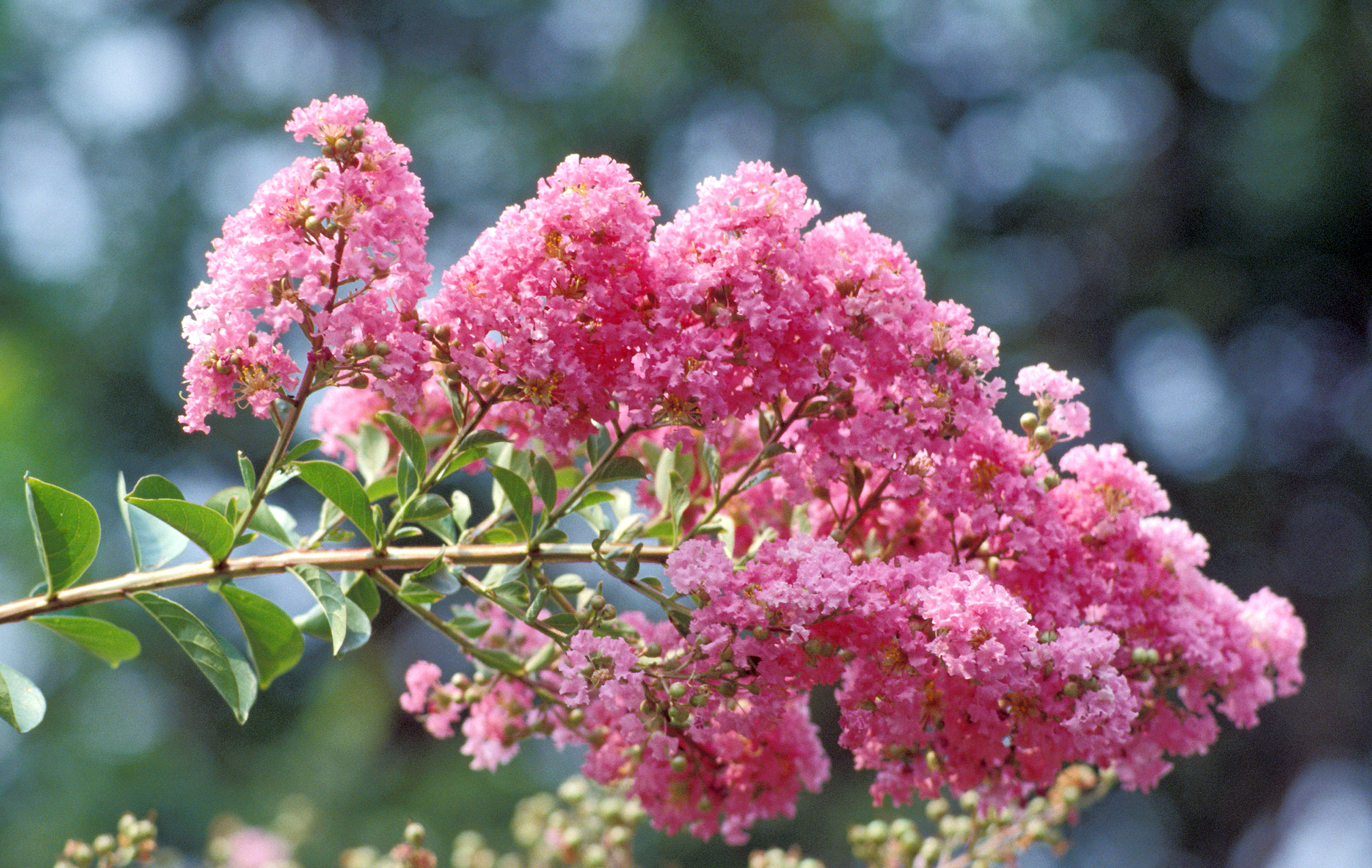
Crape Myrtle Bloom Colors And Timing: A Seasonal Guide
Crape Myrtle bloom colors include shades of pink, red, white, and purple. Blooming typically occurs from late spring to early fall.
Crape Myrtles are popular ornamental trees known for their vibrant and long-lasting blooms. These trees display a stunning array of colors, including pink, red, white, and purple, making them a favorite in gardens and landscapes. Blooming generally starts in late spring and can continue into early fall, providing a prolonged period of visual interest.
Their adaptability to various soil types and climates adds to their appeal. Proper care, including adequate sunlight and water, ensures healthy growth and abundant flowering. Planting Crape Myrtles can enhance the aesthetic value of any outdoor space.
Introduction To Crape Myrtles
Crape Myrtles are popular flowering trees. They are known for their vibrant colors and long blooming periods. These trees thrive in warm climates and bring beauty to any garden.
These trees are easy to care for and come in many varieties. Each variety has unique characteristics that make them special. Let’s explore some popular varieties and their unique traits.
Popular Varieties
- Natchez: This variety has white blooms and grows up to 30 feet.
- Tonto: Known for its bright red flowers, it reaches 10-15 feet.
- Muskogee: Lavender-pink blooms and can grow up to 25 feet.
- Sioux: Features pink blooms and grows up to 20 feet.
- Dynamite: Vibrant red flowers and grows up to 20 feet.
Unique Characteristics
Crape Myrtles have some unique characteristics. Their bark peels naturally, revealing a smooth, colorful surface underneath. This adds to their year-round appeal.
These trees bloom in summer and continue into fall. They come in many colors: white, pink, red, and purple. Their long blooming period makes them a favorite among gardeners.
Here is a table summarizing some key features:
| Variety | Bloom Color | Height (feet) |
|---|---|---|
| Natchez | White | 30 |
| Tonto | Red | 10-15 |
| Muskogee | Lavender-Pink | 25 |
| Sioux | Pink | 20 |
| Dynamite | Red | 20 |
These unique traits make Crape Myrtles a stunning addition to any landscape. Their vibrant blooms and peeling bark provide visual interest throughout the year.

Credit: www.rainbowgardens.biz
Bloom Colors Explained
The Crape Myrtle is famous for its vibrant bloom colors. These colors make gardens lively and cheerful. Understanding the range and factors affecting these colors helps you plan better.
Color Range
Crape Myrtles offer a stunning array of colors. The most common shades include:
- Red
- Pink
- Purple
- White
- Lavender
Each color can add a unique charm to your garden. The color depends on the variety you choose. Here’s a quick reference table:
| Color | Variety |
|---|---|
| Red | Dynamite, Red Rocket |
| Pink | Pink Velour, Sioux |
| Purple | Twilight, Catawba |
| White | Natchez, Acoma |
| Lavender | Apalachee, Muskogee |
Factors Affecting Color
Many factors can affect the color of Crape Myrtle blooms. These include:
- Soil pH: Acidic soil can intensify colors.
- Sunlight: More sunlight can make colors brighter.
- Watering: Proper watering helps maintain vibrant colors.
- Climate: Warmer climates enhance the bloom’s vividness.
Make sure to monitor these factors for the best bloom colors.
Seasonal Bloom Timing
Crape Myrtles are known for their vibrant and colorful blooms. These beautiful trees and shrubs brighten up any garden. Understanding their bloom timing can help you plan your garden better. Let’s dive into the seasonal bloom timing of Crape Myrtles.
Spring Blooms
In spring, Crape Myrtles start to show signs of life. New leaves begin to sprout. By late spring, the first buds appear. These early blooms are often soft and delicate. Colors range from light pink to white. This initial bloom sets the stage for a summer spectacle.
Summer Blooms
Summer is when Crape Myrtles truly shine. The blooms become more vibrant and plentiful. By mid-summer, the trees are covered in flowers. Colors range from deep reds to bright purples. Some varieties even have multiple colors on one plant. This makes them a stunning focal point in any garden.
| Season | Bloom Characteristics |
|---|---|
| Spring | Light pink to white, early and delicate blooms |
| Summer | Deep reds, bright purples, more vibrant and plentiful |
To summarize, understanding the seasonal bloom timing of Crape Myrtles can help you enjoy a colorful garden from spring to summer. Keep an eye on these beauties as they transition through their blooming phases.

Credit: landscapedesignbylee.blogspot.com
Regional Bloom Differences
Understanding the regional differences in crape myrtle bloom colors and timing is essential. Crape myrtles showcase their vibrant blooms across various regions in the United States. Each region offers unique bloom characteristics due to climate and environmental factors. Below, we delve into the specific regional bloom differences.
Southern Regions
In the Southern regions, crape myrtles thrive due to the warm climate. These areas typically see crape myrtle blooms earlier in the year.
Key Characteristics:
- Bloom Timing: Late spring to early summer
- Common Colors: Red, pink, purple, white
The extended warm season allows for a longer blooming period. Gardeners often enjoy vibrant colors from May through September.
Northern Regions
In the Northern regions, crape myrtles face a shorter growing season. Cooler temperatures delay the bloom time compared to southern areas.
Key Characteristics:
- Bloom Timing: Mid to late summer
- Common Colors: Pink, lavender, white
The blooms in northern regions may last until early fall. The colder climate restricts the variety of colors available.
Summary Table:
| Region | Bloom Timing | Common Colors |
|---|---|---|
| Southern Regions | Late spring to early summer | Red, pink, purple, white |
| Northern Regions | Mid to late summer | Pink, lavender, white |
Maximizing Bloom Potential
To get the most stunning blooms from your crape myrtle, you need the right conditions. This section explains how to maximize your crape myrtle’s bloom potential. Follow these tips to enjoy vibrant colors and long-lasting blooms.
Ideal Soil Conditions
Crape myrtles thrive in well-drained soil. Ensure the soil has a slightly acidic to neutral pH, between 5.5 and 7.0. You can test the soil pH with a simple kit from a garden store.
To improve soil quality, add organic matter like compost. This helps the soil retain moisture and nutrients. Avoid using heavy clay soils, as they can cause root rot.
| Soil Type | Suitability |
|---|---|
| Well-drained loam | Excellent |
| Sandy soil | Good |
| Heavy clay | Poor |
Watering Tips
Proper watering is crucial for crape myrtles. Water the plant deeply at least once a week. This encourages deep root growth.
During the first year, water more frequently to establish the roots. In hot, dry weather, increase watering to twice a week.
- Water early in the morning.
- Avoid wetting the leaves to prevent fungal diseases.
- Use mulch to retain soil moisture.
Mature crape myrtles are drought-tolerant, but young plants need consistent moisture. Never let the soil dry out completely.
Pruning For Color And Timing
Understanding the importance of pruning can enhance your Crape Myrtle blooms. Proper timing and technique ensure vibrant colors. Follow these steps to achieve beautiful blooms.
Best Pruning Practices
Pruning your Crape Myrtle correctly is crucial. Here are the best practices:
- Use clean, sharp tools.
- Remove dead or diseased branches first.
- Cut back to the main branch or trunk.
- Avoid ‘topping’ the tree.
- Thin out crowded branches.
Prune the branches to allow light and air to reach all parts of the plant. This encourages healthy growth and more flowers.
Timing Your Pruning
Timing is critical for the best bloom colors. Follow these guidelines:
| Season | Action |
|---|---|
| Late Winter | Best time for major pruning. |
| Spring | Light trimming for shape. |
| Summer | Remove spent flowers. |
Prune in late winter for the most blooms in summer. Avoid pruning in fall as it can damage the plant.
Common Issues And Solutions
Crape Myrtles are beloved for their vibrant bloom colors and timing. Yet, these beautiful plants can face common issues. This section covers pest management and disease prevention to help you maintain healthy Crape Myrtles.
Pest Management
Pests can cause significant damage to your Crape Myrtles. Here are some common pests and how to manage them:
- Aphids: These small insects suck sap from the leaves. Spray with soapy water or use neem oil.
- Japanese Beetles: These beetles can chew through leaves. Handpick them or use traps to control their population.
- Scale Insects: These pests appear as small, round bumps. Use horticultural oil to smother them.
Regular inspection is key to catching these pests early. Act quickly to prevent infestations.
Disease Prevention
Diseases can impact the health and beauty of your Crape Myrtles. Here are some common diseases and prevention tips:
| Disease | Symptoms | Prevention |
|---|---|---|
| Powdery Mildew | White, powdery spots on leaves | Ensure proper air circulation and avoid overhead watering |
| Leaf Spot | Dark spots on leaves | Prune affected areas and dispose of fallen leaves |
| Root Rot | Wilting and yellowing of leaves | Ensure well-draining soil and avoid overwatering |
By following these tips, you can keep your Crape Myrtles healthy and vibrant. Regular care and attention are essential for preventing both pests and diseases.
Choosing The Right Crape Myrtle
Choosing the right crape myrtle can transform your garden. The bloom colors and timing play a huge role. Whether you want vibrant reds or soothing whites, choosing wisely matters. This guide helps you select the perfect crape myrtle for your needs.
Garden Aesthetics
Your garden’s look is crucial. Crape myrtles offer colors like red, pink, white, and purple. Think about your garden’s color scheme. Do you want a bold statement or a subtle touch?
- Red: Creates a striking focal point.
- Pink: Adds a soft, romantic feel.
- White: Brings a clean, classic look.
- Purple: Offers a unique, royal touch.
Consider the tree’s size too. Dwarf varieties suit small gardens. Taller types fit well in larger spaces. Matching the tree’s size with your space keeps the garden balanced.
Climate Considerations
Crape myrtles thrive in warm climates. They need full sun to bloom well. Ensure your area gets enough sunlight. These trees tolerate drought but prefer well-drained soil.
Cold climates require special attention. Some crape myrtles are more cold-hardy. Look for varieties that withstand lower temperatures. Planting in protected areas helps too.
| Climate | Recommended Varieties |
|---|---|
| Warm | Muskogee, Natchez |
| Cold | Acoma, Hopi |
Watering needs vary. Young trees need more water. Mature trees are more drought-tolerant. Mulching helps retain soil moisture. Regular pruning encourages healthy growth.

Credit: newswire.caes.uga.edu
Frequently Asked Questions
What Crape Myrtle Has The Longest Bloom Time?
The Natchez crape myrtle has the longest bloom time. It blooms for up to 100 days, from late spring to fall.
What Color Do Crape Myrtles Bloom?
Crape myrtles bloom in various colors, including pink, red, purple, white, and lavender. These vibrant blooms enhance garden beauty.
When Should I See Buds On My Crepe Myrtle?
Crepe myrtle buds typically appear in late spring to early summer. Warmer climates may see buds earlier. Ensure proper sunlight and care.
How Can I Make My Crepe Myrtle Bloom More?
To make your crepe myrtle bloom more, ensure full sun exposure, water deeply, and apply balanced fertilizer. Prune dead branches and remove suckers. Mulch to retain moisture.
Conclusion
Choosing the perfect crape myrtle bloom colors can transform your garden. Understanding their bloom timing ensures vibrant displays all season. Enjoy the beauty and diversity these stunning trees offer. With proper care, your crape myrtles will flourish, adding charm to your outdoor space.
Explore different varieties to find the best fit for your landscape.

